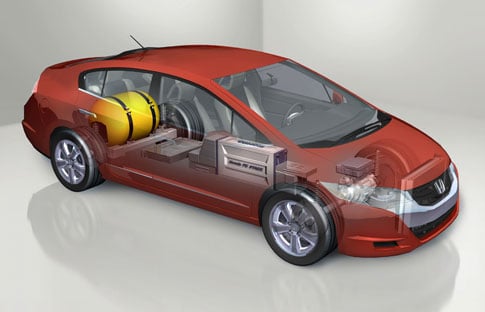Overview

Many companies are currently researching and developing hydrogen cars. Funding has come from both private and government sources. Development is largely the result of interests in limiting the environmental impact of automobiles, as the only emissions of fuel cells vehicles is water. As long as the hydrogen is prepared without the use of fossil fuel input, the propulsion of a fuel cell automobile will have no contribution to carbon dioxide emissions. Hydrogen fuel cell cars also travel farther on a given volume of fuel than their gasoline powers counter parts.
The drawbacks of hydrogen use are: low energy content per unit volume, high tankage weights and storage pressures, and a lack infrastructure such as fueling stations. Many companies such as General Motors and the Ford Motor Company are also downsizing or abandoning their plans to develop hydrogen cars due to production costs and market uncertainty.
Most hydrogen automobiles cost about $400,000 and are currently only available as demonstration models in limited numberers on a lease system. There is an estimated 200 hydrogen-powered cars in the United States, mostly in southern California where there are “fast-fill” hydrogen stations available. Both Japan and Germany have announced plans to open 1,000 hydrogen fill stations in support of environmentally friendly development. London’s deputy mayor, Kit Malthouse, announced plans to have a hydrogen taxi and bus system in operation by the 2012 Olympic Games.
Honda FXC Clarity
The Honda FCX Clarity is a hydrogen fuel cell automobile that was released to the consumer public in 2008[1][1]. It is currently available for lease in Japan, Europe and Southern California. There is a total of 50 FCX Clarity leased in the US, 10 in Europe, and 10 in Japan. Honda believes it could start mass producing vehicles based on the FCX Clarity by 2018, but the number of available hydrogen stations is a limiting factor.
The FCX Clarity is produced in Japan on a dedicated assembly line in the Honda New Model Center. The fuel cell stacks are produced at Honda Engineering Co., Ltd. Honda hopes to produce 200 vehicles by 2010.
The FCX Clarity was the first hydrogen fuel cell-powered vehicle available for customer retail.
Iceland's Hydrogen Fuel Cell Public Bus
Hydrogen fuel cell vehicles, as stated, are incredibly expensive. Individual automobile drivers are unlikely to make such a pricey private investment, but governments and large corporations have been more willing to invest in the technology when it's utility can be enjoyed by the public. The Ecological City Transport System (ECTOS) project began in 2001 as part of the European Commission's endeavor to reduce overall emissions in Europe. As part of it's research into hydrogen fuel cells, Icelandic New Energy (INE) entered into business with multinational energy corporations such as Shell, DaimlerChrysler, and NorskHydro [2], the University of Iceland, and the University of Stüttgart[3]. These public buses now proudly shuttle people around the city of Reykjavík. It is through these types of multinational, intergovernmental collaborations that such seemingly insurmountable goals can be achieved.
Hydrogen fuel cells generate electricity between the reaction of hydrogen and oxygen to make water. Hydrogen can be split from H20 using electrolysis. Since the energy used for electrolysis in Icelandic buses would be drawn from a grid that is run on renewable geothermal energy, this technology has proven to be highly efficient and emits no carbon[3]. In other contexts, the technology would be far less renewable were the energy to come from a coal fired power planet, for example.
Links
Mercedes Benz Electric Vehicle
Video: NOVA fuel cell with hosts of "Car Talk"
Video: Inside World's first hydrogen-powered production car
References
- ↑ 1.0 1.1 http://automobiles.honda.com/fcx-clarity/ Cite error: Invalid
<ref>tag; name "FCX" defined multiple times with different content - ↑ http://odewire.com/57591/professor-hydrogen.html
- ↑ 3.0 3.1 http://ec.europa.eu/research/environment/newsanddoc/article_3894_en.htm